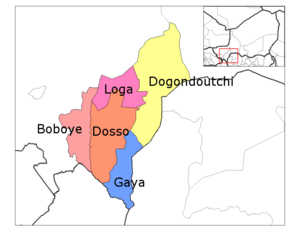Dosso Region
| Dosso | |
|---|---|
| Region | |
 Location within Niger | |
| Coordinates: 13°03′N 3°12′E / 13.050°N 3.200°ECoordinates: 13°03′N 3°12′E / 13.050°N 3.200°E | |
| Country |
|
| Capital | Dosso |
| Area | |
| • Total | 31,002 km2 (11,970 sq mi) |
| Population (2011[1]) | |
| • Total | 2,078,339 |
| • Density | 67/km2 (170/sq mi) |
| Time zone | West Africa Time (UTC+1) |
Dosso is an administrative Region of the Republic of Niger. The region has an area of 31,002 square kilometres (11,970 sq mi) with a population of 2,078,339 in 2011 based projections by the National Institute of Statistics.[2]
History
The region of Dosso has a rich history through the Dosso Kingdom. The capital city of the region was once the capital of the Dosso kingdom. In present day, the palace of the Sultanat of Dosso is the symbol of the aristocratic ruling class of the kingdom. The region was traditionally populated by Zarma people who are believed to have migrated from the Fula region around Lake Debo in Mali during the Songhai Empire. Although zarma people remain the largest community in Dosso today, the region, like the rest of Niger, is multiethnic in makeup.
Demographics
Like most regions of Niger, the population of the region of Dosso has rapidly grown since the independence. From 693,207 in 1977, its population has increased 1,018,895 by 1988, and 1,479,095 by 2001. Dosso region has the third highest population density (61.4 inhabitants/km2) behind Niamey and Maradi regions.[3] Most people live in rural areas and only 10.4% of the population resides in urban cities.[3] Other demographic statistics are similar to the national averages.[3]
Divisions and borders

Dosso is divided into 5 Departments (Boboye Department, Dogondoutchi Department, Dosso Department, Gaya Department and Loga Department), 5 urban administrative divisions (communes urbaines) and 38 rural administrative divisions (communes rurales), 1 province, 15 cantons and 3 nomadic grouping.[4]
Dosso has the following foreign borders:
- Sokoto State, Nigeria - east
- Kebbi State, Nigeria - southeast
- Alibori Department, Benin - south
Domestically, it borders the following departments:
- Tahoua Region - northeast
- Tillabéri Region - west
See also
References
- ↑ Annuaire statistique du Niger
- ↑ Evolution of the population by regions. National Statistics Institute of Niger (retrieved in 7/22/2014).
- 1 2 3 Dosso in Numbers 2011. Statistics on Dosso Region (retrieved on 7/22/2014).
- ↑